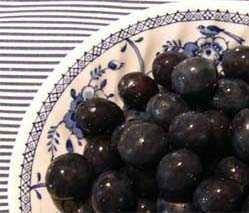Damson Cheese Recipe: for savoury and sweet dishes. How to freeze damsons/plums.
Posted by Fiona Nevile in Jam Jelly and Preserves | 65 comments
A dish of ripe damsons
At this time of year, we are given a lot of fruit for preserves. Quite often we pop them in the freezer (how to freeze damsons? See tricks and tips below) until we have time to turn it into something delicious. This morning we decided to make damson cheese.
Damson cheese is not cheese as we know it, Jim. It’s sweet, full of flavour and so dense with fruit that it is sliced, just like cheese. It’s tasty and just that bit more unusual than jelly. I do regret the occasion when my mum gave me a jar ten years ago; I didn’t even taste it before it died a furry death in my fridge. Now I know better.
Traditionally, damson cheese is sliced and served with lamb or game. We eat it with cheese and quite often have it as a pud with a dollop of cream. A slice on an individual plate of hors d’oeuvres looks classy.
Damson cheese is well worth adding to your repertoire.
If you are going to make damson cheese, make sure that you have some straight sided glass jars, or earthenware pots to pour it into so that you can easily slide it out for slicing. (Why not plastic? See tips and tricks below).
Recipe for our excellent damson cheese:
Ingredients:
- 2lbs/917gms of damsons
- 1/4pt/150ml of water
- White granulated sugar (1lb to each 1pint of damson puree)
- A squeeze of lemon juice( approximately 1/2 tsp)
Method:
- Wash, pick over and discard bad fruit.
- Put damsons and water in a large heavy bottomed saucepan. Bring gently to simmering point and simmer very gently until all fruit is soft and falling of the stones (this can take at least an hour or more). Keep an eye on it, stirring from time to time.
- When fruit is very soft, remove from the heat and cool before straining and pressing through a medium sieve. Discard the stones.
- Pour fruit into a measuring jug, note the quantity and return to the cleaned pan with the sugar and lemon juice.
- Stir over a gentle heat stir until sugar is dissolved.
- Bring to the boil and continue to boil briskly. Stir constantly, to stop the sugar burning on the base of the saucepan. Don’t skip this bit.
- The damson cheese it ready when the spoon makes a clear track mark on the bottom of the pan. Not a parting of the seas but but a glimpse of the bottom.
- Ladle into warmed, sterilised straight sided jars. (How do I sterilise jars and lids? See tricks and tips below).
- Allow to cool a little, whilst still warm, and cover with sterilised plastic lined screw topped lids or waxed disks and cellophane covers.
- Label when cold and store in a cool, dark, dry area. It should keep for a year.
- Once opened, keep in the fridge and eat within a month or so.
Tips and tricks:
How to freeze damsons (also how to freeze plums, blackberries, greengages, wild damsons and sloes):
- Pick over fruit and discard any bad fruit
- Wash fruit and dry in a large clean tea cloth
- Put fruit into labelled bags and freeze
Why can’t I use plastic (i.e. ice cream cartons, to store damson cheese in my fridge?
- A friend, who is a great chef, made a batch of damson cheese purely for personal consumption. The damson cheese was poured into a large clean, sterilised ice cream carton. Every now and then, a sizeable nugget of damson cheese was savoured. After a few months (once opened damson cheese keeps for ages in the fridge) the plastic tainted the damson cheese and the private cache had to be thrown out. Glass and earthenware are fine for damson cheese. After opening, store in the fridge.
How do I sterilise jars and lids?
- Sterilising the jars and lids:
We collect jars all year round for our jelly, chutney and jam making sessions. I try to soak off labels and store the clean jars and metal plastic coated screw-top lids in an accessible place. The sterilising method that we used is simple. Just before making the ‘cheese’, I quickly wash and rinse the jars and place them upside down in a cold oven. Set the temperature to 160c/140c for fan assisted. When the oven has reached the right temperature I turn off the heat. The jars will stay warm for quite a while. I only use plastic lined lids for preserves as the all-metal lids can go rusty. I boil these for five minutes in water to sterilise them. If I use Le Parfait jars, I do the same with the rubber rings.
Leave a reply





Was looking for a damson walnut terrine recipe, but was unable to find one. Have adapted your damson cheese recipe and it looks and tastes great on crackers.
Same quantities plus 150gms of walnut pieces place in the boiling damsons about half way thru the final cook. Set the mixture in a square high sided casserole dish. Allowed to set, tipped out and cut into manageable sized piece for freezing.
Great with cheese, a cracker biscuits and a wine.
Hi, I can’t wait to try this recipe, it looks wonderful. I only have victoria plums, do you think it will work as well? Also, how much does this recipe make, preferably in ml?
thanks!
Great – thanks Duncan – will give it a go.
Tracey